While last week was an orgy of drips, smears, and spills, it was only half of the overall effort. Testing dyes to produce the one and twenty minute shades gave me a pile of sodden colors, but it’s not dubbing until it’s teased, torn, and turned into filament.
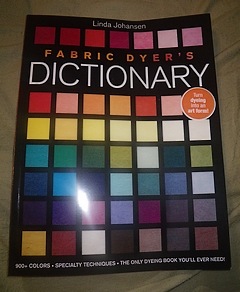 Wet dyeing is a mixture of chance and things we can bend to our will, “dry dyeing” allows us to micro-manage color and turn lemons into lemonade.
Wet dyeing is a mixture of chance and things we can bend to our will, “dry dyeing” allows us to micro-manage color and turn lemons into lemonade.
It also allowed me to experiment with a fabric color bible, and their recipes for 900 different colors from component colors.
I picked up the Fabric Dyer’s Dictionary ($16.29) from Amazon.com, figuring fabric and its rough weave might approximate dubbing colors fairly well. This particular book isn’t as useful as I’d hoped as it’s limited to the fiber reactive liquid dyes used on vegetable fibers, like soy, hemp, jute, silk, and cotton.
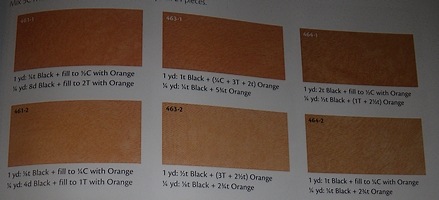
It does list the components of each hue – which may be enough for the casual colorist to get within striking distance of the color desired, but you’ll have to develop a conversion from liquid measure to dry, or convert your powdered dye to squeeze bottles as they suggest.
As the liquid phase of the project was complete, I’d need to convert their teaspoons and tablespoons into pinches of dubbing.
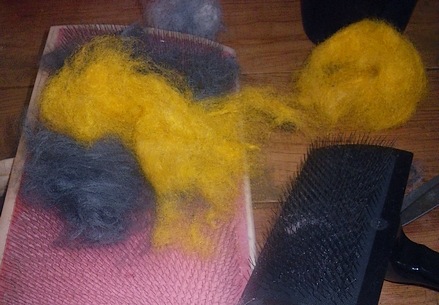
A couple of dog brushes, a gauze mask, and elbow grease is all that’s required, that and plenty of fur in as many colors as possible.
You can’t use blenders on fibers that are measured in microns, this is more of the Singlebarbed’s Whizbang Dry Fly dubbing and the average fiber is only 12 microns wide – about one-thirtieth a strand of wool fiber, it’s gossamer and sticks to everything – and will only bind into clumps with blender use.
Tearing the fibers between the grooming combs aligns them in parallel and starts the blending of color.
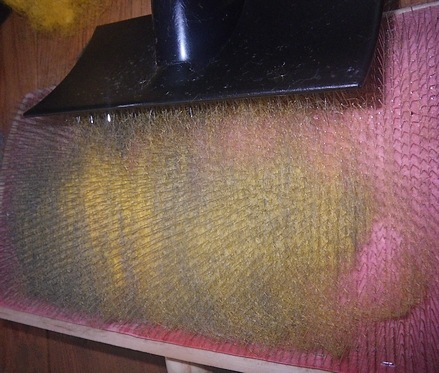
Now it’s only a matter of how complete of a color blend you want. As an impressionist I’d rather have some streaks of the components available as it allows me to fine tune the actually fly by selecting a bit more yellow or a bit less, ditto for the gray.
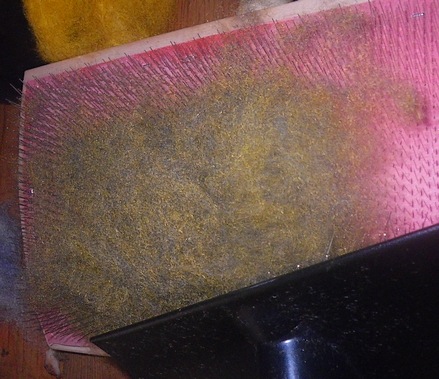
Considering that you can do the same with existing packs of fur you’ve purchased from the fly shop, dry dyeing allows you to build custom colors unique to your fishery with little mess.
The above yellow-gray blend has been through about four blending passes to achieve this level of mix. Each pass was scraped against the other repeatedly, then lifted off the bottom comb by scraping the top “with the grain” and towards you, then laid down again on the bottom comb to repeat the process.
This is about as far as I’ll take each blend. It gives about four shades of color from a single clump, depending on whether you take the fur from a yellowish area or a predominantly gray section.

The final blend with its component colors – the flash has lightened the original gray measurably. The color is a good muddy gray – liable to be someone’s secret color somewheres.
Considering the ultra-fine filament size necessary for a good dry fly dubbing, the rending process will have particles in orbit all around you. If you’re sitting down to a extended session wear a simple mask to avoid inhaling the bunny, beaver, or filament you’re tinkering with, it’s only prudent.
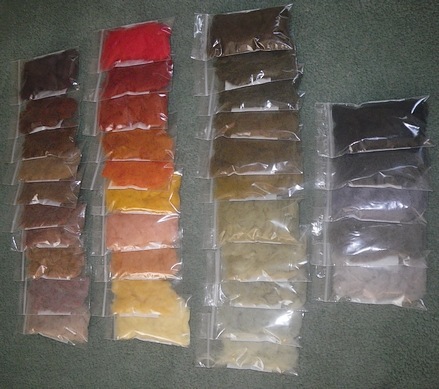
It doesn’t take much to yield a spectrum of colors suited to your watershed – and contrary to vendor offerings, you’ll have few wasted colors, and they’ll be complex blends – none of the drab monotones that dominate commercial dry fly dubbing.
I’ve concentrated the colors above in the olive and brown range, giving me 10 shades of each, plus 5 shades of gray, and a quick spectrum of warm colors suitable for most of the common California colors of mayfly and caddis.
This is just a start however, as I’m building a comprehensive selection to replace all the odd packs of vendor dubbing accumulated over a couple of decades.
Fly-Rite, Spectrum, Hareline, and all the traditional flavors just cannot compete with a naturally floating filament measured in microns. They’ll be relegated to a dimly lit drawer once I’ve matched all the remaining hues needed.
The color syllabus can only be used as a hint for the colors to clump on the combs, but as dry dyeing offers you complete control – you can add a pinch of what’s missing and match an exact color very quickly.
Something for you to tinker with while waiting for the creeks to subside.
Tags: bulk fly tying materials, dry fly dubbing, dry dyeing, fly tying blog, fly tying, fabric dyer’s dictionary, Hareline, fly-Rite, Spectrum, fly fishing, dog comb,

posts like this make me realize how basic I really am with fly tying/fishing. Keith, you’re a machine. An obsessive, compulsive, machine.
Sounds like you need to do some experimentation with stripping/dyeing quills for dry flies. Hint…
@ray – completely guilty of unimaginable crimes including doodling dry flies on the pages of my high school math textbook.
@trout – I usually get those for free when I dye necks. Naturally my focus is the hackle color, and the stems and seeds are an added bonus.
I’ll see if I can sacrifice some necks for the greater good.
Frankly, I’m becoming concerned about you. This color thing is acquiring the patina of one of those people who wanders around the streets outside sci-fi conventions in full Klingon regalia.
Let’s face it, most of those brownliner fish are wearing goggles (if they can see at all), and color variations beyond Hare’s Ear (The One True Bug Color) simply aren’t needed.
Just to speed things up, let’s just go ahead and schedule the intervention for early next week…
This indictment from the guy that says, “send me another ounce of Chandler Red, but make it lively this time ..”
See what I mean? If they’ll eat Fire-Engine Red, they don’t need blended colors.
BTW – the Wonderdog needs a good brushing. Since you’re obviously well-equipped in the dog brush department, what time is good for you?
The Wonderdog is possessed with a most appealing brown-black guard hair. As he’s entirely ignorant of anything other than his gastro-intestinal tract, I’ll be looking for a couple of pounds once I start the nymph mixes.
I bet he’s as pink as a piglet when shorn.
I keep wondering where I’m going to find the time to do all this dyeing, tearing and flocking; even if Lewey the Dachshund and Miss Kitty let me shear them?
Brilliant, innovative idea.
Its a pity those books that claim to show good techniques give the same old tired tips.
Well done.
Please feel free to visit my site, I have a few good tips that you wont find in the books either